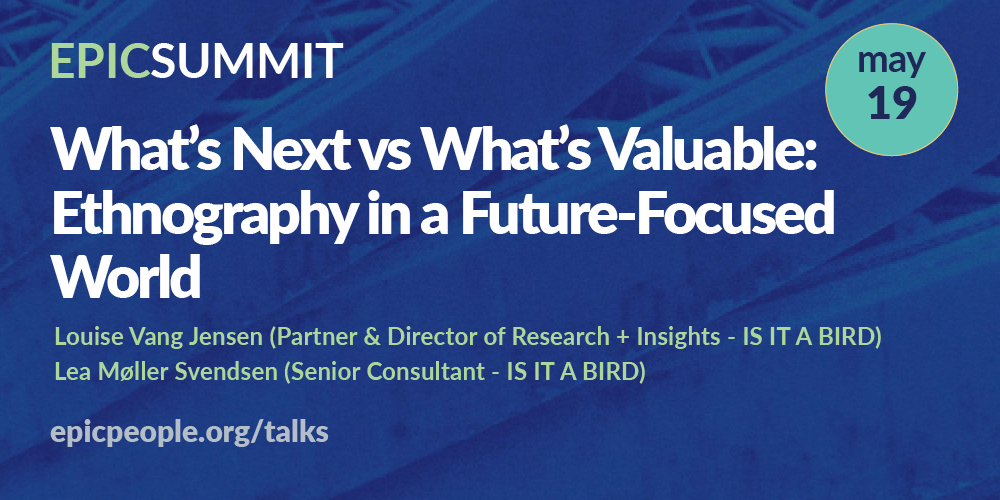Does the intense focus on “what’s next” come at the expense of “what’s valuable”? Why is it considered more important to design for what is changing than what we want to hold on to?
An EPIC Summit with [contrib_author post_id=’38978′ name=’Louise Vang Jensen’] & [contrib_author post_id=’38978′ name=’Lea Møller Svendsen’], IS IT A BIRD

OVERVIEW | AGENDA | PRESENTERS | READING & RESOURCES | WHAT TO EXPECT
Overview
Industries, organizations and governments are hungrily focused on the future—working diligently to predict it and de-risk it, stay relevant and resilient in the face of it, envision and invent and disrupt it. Ethnographers are valuable to these endeavors because we have advanced expertise and finely honed techniques for understanding social and technological change. But ethnographers also challenge prevailing orientations toward the future:
Does the intense focus on “what’s next” come at the expense of “what’s valuable”? Why is it considered more important to design for what is changing than what we want to hold on to? Can the pace of contemporary technological change obscure the non-linear way in which societies and values actually unfold? Could an ethnographic approach that de-centers ‘the future’ actually enable organizations to be more resilient over time?
In this Summit we explore how we actually do ethnography—grounded in the rich social context of the present—in future-focused spaces driven by engineering and business logics. Louise Vang Jensen and Lea Møller Svendsen will present an ethnographic framework for futures, developed over the course of collaborations with global companies like VELUX, Novo Nordisk and Maersk. Lea and Louise will unpack three projects for multinational firms in which ethnographers collaborated with clients and stakeholders to re-design futures projects. They link micro and macro levels of people’s social and cultural contexts, and apply design tools to enable conversations about what is valuable today and what future scenarios are not just imaginable, but also desirable. Following the presentation, participants will gather together in small groups to focus on future-study tools and tactics.
Agenda
- 8-8:15: Welcome Mingle
- 8:15-9:10: Presentation
- 9:10-9:20: Break & Transition to Working Groups
- 9:20-10:00: Working Groups
- 10:00-10:30: Networking + Presenter Meet & Greet
Presenters
 Louise Vang Jensen (Partner and Director of Research & Insights – IS IT A BIRD). Louise has been with the Copenhagen based innovation agency IS IT A BIRD since the early start-up days of the company ten years ago. She has played a key role in enabling and establishing the human centred agency’s current position as a preferred partner to global leading brands. Louise is a trained social anthropologist and management consultant, dedicated to turning human understanding into sustainable business opportunities, informing and innovating business strategy, new products and services and innovation capacity.
Louise Vang Jensen (Partner and Director of Research & Insights – IS IT A BIRD). Louise has been with the Copenhagen based innovation agency IS IT A BIRD since the early start-up days of the company ten years ago. She has played a key role in enabling and establishing the human centred agency’s current position as a preferred partner to global leading brands. Louise is a trained social anthropologist and management consultant, dedicated to turning human understanding into sustainable business opportunities, informing and innovating business strategy, new products and services and innovation capacity.
 Lea Møller Svendsen (Senior Consultant – IS IT A BIRD). Lea is a trained social anthropologist and long-time consultant at IS IT A BIRD, where she is managing ethnographic insights and futures studies for various industry-leading companies. In her work, Lea is driven by the urge to bring ethnographic thick data and anthropological analytical thinking to life in future-focused design processes. Lea combines curiosity, empathy and creativity to identify extraordinary opportunities through the deep knowledge about peoples’ ordinary lives. Lea is ambitious on behalf of clients and projects and steers future transformations guided by principles of what is valuable to people in their current ways of living.
Lea Møller Svendsen (Senior Consultant – IS IT A BIRD). Lea is a trained social anthropologist and long-time consultant at IS IT A BIRD, where she is managing ethnographic insights and futures studies for various industry-leading companies. In her work, Lea is driven by the urge to bring ethnographic thick data and anthropological analytical thinking to life in future-focused design processes. Lea combines curiosity, empathy and creativity to identify extraordinary opportunities through the deep knowledge about peoples’ ordinary lives. Lea is ambitious on behalf of clients and projects and steers future transformations guided by principles of what is valuable to people in their current ways of living.
Learn more about IS IT A BIRD.
What to Expect
Summit Director, Lydia Timlin-Broussard, shares what to expect at the first EPIC Summit.
Reading & Resources
Suggested reading/watching for the session:
Reconsidering the Value of Wearables, Sakari Tamminen
Anticipating Credible Futures (tutorial), Rich Radka
Speakers will draw on ideas and theory from these texts:
Halse, Joakim (2014), Ethnographies of the Possible: The Temporality of Design. In Design Anthropology: Theory and Practice. Ed. Wendy Gunn, Ton Otto & Rachel Charlotte Smith. Bloomsbury.
Haraway, Donna (2016), Staying with the Trouble: Making Kin in the Chthulucene. Duke University Press. 2016.
Mead, G. H. (2002 [1932]) The Philosophy of the Present. Prometheus Books.
Montuori, Alfonso (2003), The Complexity of Improvisation and the Improvisation of Complexity: Social Science, Art and Creativity. Human Relations 56:2.
Pink, Sarah et. Al, ( 2017), Anthropologies and Futures: Setting the Agenda. In Researching Emerging and Uncertain Worlds. Bloomsbury.
Rabinow, P., & Marcus, G. E. (2008) Designs for an Anthropology of the Contemporary, Durham, NC: Duke University Press.
